Sharpening Lawn Mower Blades: A Step-by-Step Guide with Angle Grinder

Keeping your lawn mower blades sharp is essential for maintaining a healthy and vibrant lawn. Dull blades can tear grass instead of cutting it cleanly, which can lead to a weakened lawn and an increased risk of disease. Instead of spending money on a professional blade sharpening service, you can easily sharpen your lawn mower blades at home using an angle grinder. In this step-by-step guide, we will walk you through the process of sharpening your lawn mower blades with an angle grinder, ensuring that your grass gets the clean cut it deserves.
The first step in sharpening your lawn mower blades is to ensure your safety. Before starting any blade sharpening activities, be sure to disconnect the spark plug wire to prevent accidental engine starts. Additionally, wearing protective gloves and safety glasses is highly recommended to protect yourself from any flying debris. Once you have taken all the necessary safety precautions, you can begin the sharpening process.
Start by removing the mower blade from your lawn mower. This can usually be done by loosening the bolt that holds the blade in place. Once the blade is removed, clean it thoroughly with a wire brush to remove any dirt and debris. This will make it easier to see the areas that need to be sharpened. It is important to note that only the cutting edges of the blade need to be sharpened, so be sure to inspect the blade carefully to determine which side should be facing up during the sharpening process.
Now it’s time to sharpen the blade using an angle grinder. An angle grinder with a grinding wheel specifically designed for sharpening blades is the best tool for the job. Place the blade securely in a vise, making sure it is stable and immobile. Then, use the angle grinder at a consistent angle (generally around 45 degrees) to sharpen the cutting edges of the blade. Apply even pressure and move the grinder along the cutting edge in a smooth, controlled motion. Repeat this process until the cutting edges are sharp and shiny.
Once you are satisfied with the sharpness of the blade, reinstall it onto the lawn mower. Make sure the blade is properly tightened to avoid any safety hazards. Finally, reconnect the spark plug wire and start your lawn mower to ensure that the blade is functioning properly. You should notice a significant difference in the quality of the cut and the overall health of your lawn.
In conclusion, sharpening your lawn mower blades with an angle grinder is a straightforward process that can easily be done at home. By following this step-by-step guide, you can maintain a healthy and vibrant lawn without the need for professional blade sharpening services. Remember to always prioritize safety and wear the necessary protective gear. Happy sharpening!
Why is sharpening lawn mower blades important?
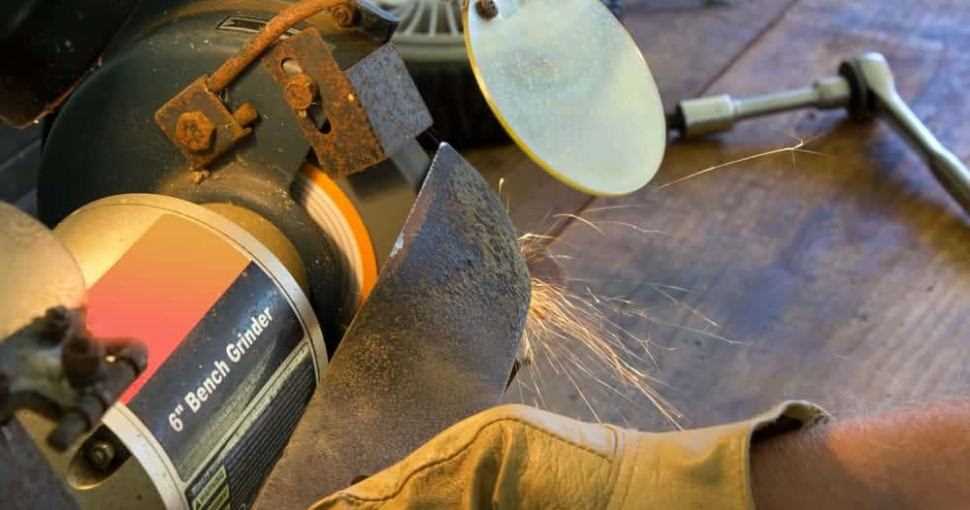
Regularly sharpening lawn mower blades is essential for maintaining a healthy and well-manicured lawn. Blunt blades can tear the grass instead of making a clean cut, which can lead to a variety of issues.
Enhances the overall appearance: Sharpened blades ensure a clean and precise cut, resulting in a visually appealing and professionally trimmed lawn.
Promotes healthy grass growth: Dull blades can damage grass, causing it to become susceptible to diseases and pests. When the grass is cut cleanly, it can heal faster and encourages healthy regrowth.
Improves mower efficiency: A sharp blade slices through the grass effortlessly, reducing the strain on the mower’s engine and improving fuel efficiency. This can save time and money in the long run.
Minimizes the risk of lawn diseases: A clean cut from sharp blades reduces stress and damage to the grass, making it less prone to infections and diseases. This helps maintain a vibrant and disease-free lawn.
Eliminates dull blade problems: Dull blades can leave behind uneven patches of grass, leading to an unattractive lawn. By sharpening the blades, these problems can be avoided, resulting in a more even and well-manicured lawn.
Extends the life of the lawn mower: Sharp blades reduce the workload on the mower’s engine and other parts, prolonging the overall lifespan of the machine. This can save money on repairs or the need to replace the mower sooner than necessary.
Overall convenience and satisfaction: A sharp lawn mower blade ensures an efficient and effortless mowing experience, allowing you to complete the task with ease and satisfaction.
By regularly sharpening lawn mower blades, you can maintain a healthy, vibrant, and attractive lawn while also prolonging the life of your mower. It is a simple yet important maintenance task that significantly impacts the overall lawn care routine.
What is an angle grinder?
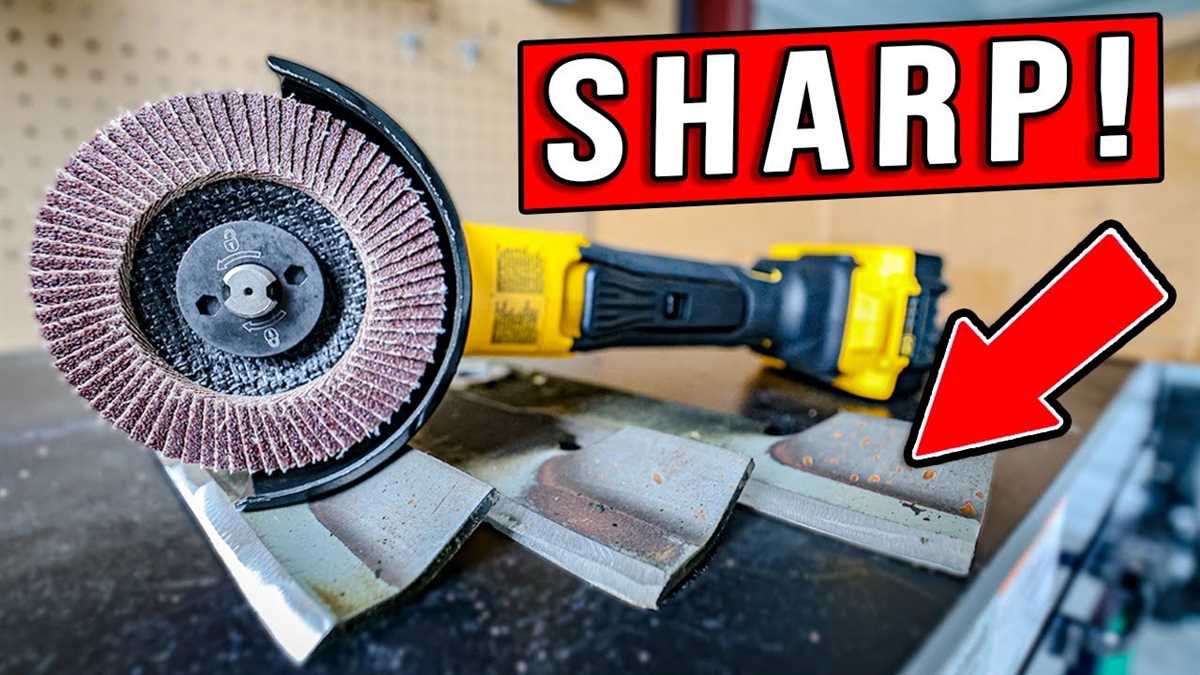
An angle grinder is a versatile power tool that is commonly used in construction and metalworking applications. It features a motor-driven abrasive disc or wheel that rotates at high speeds to perform various tasks. Angle grinders are handheld tools that are compact and easy to use, making them popular among both professionals and DIY enthusiasts.
The main components of an angle grinder include:
- Motor: The motor is the heart of the angle grinder and provides the power to rotate the disc or wheel.
- Disc or wheel: The disc or wheel is the cutting or grinding tool that attaches to the motor shaft. There are different types of discs and wheels available for various applications, such as cutting, grinding, sanding, and polishing.
- Guard: The guard is a safety feature that protects the user from debris and sparks generated by the disc or wheel during operation.
- Handle: The handle provides a grip for the user to hold and control the angle grinder during use.
- Switch: The switch controls the on/off operation of the angle grinder.
Angle grinders are known for their versatility and ability to handle a wide range of tasks, such as cutting metal pipes, grinding welds, shaping stone or concrete, and removing rust or paint. They are often used in construction, metal fabrication, and automotive repair.
Step 1: Safety precautions
Before you start sharpening your lawn mower blades with an angle grinder, it is important to take some safety precautions to prevent accidents and ensure your own well-being. Follow these steps to ensure a safe working environment:
1. Wear protective gear

Make sure you wear proper protective gear such as safety goggles to protect your eyes from sparks and debris. Wear earplugs or earmuffs to protect your hearing from the loud noise generated by the angle grinder. Additionally, wear heavy-duty gloves to protect your hands from sharp objects and cutting edges.
2. Disconnect power source
Prior to working on your lawn mower blades, always disconnect the power source. This means either unplugging the lawn mower or disconnecting the spark plug for gasoline-powered models. This step is crucial to prevent accidental startup of the mower and injury.
3. Secure the blade
Before sharpening the blade, secure it in place to prevent any movement or slippage. You can use a vice, clamps, or other sturdy tools to hold the blade in place. This will help you maintain better control over the angle grinder and prevent accidental injuries.

4. Work in a well-ventilated area
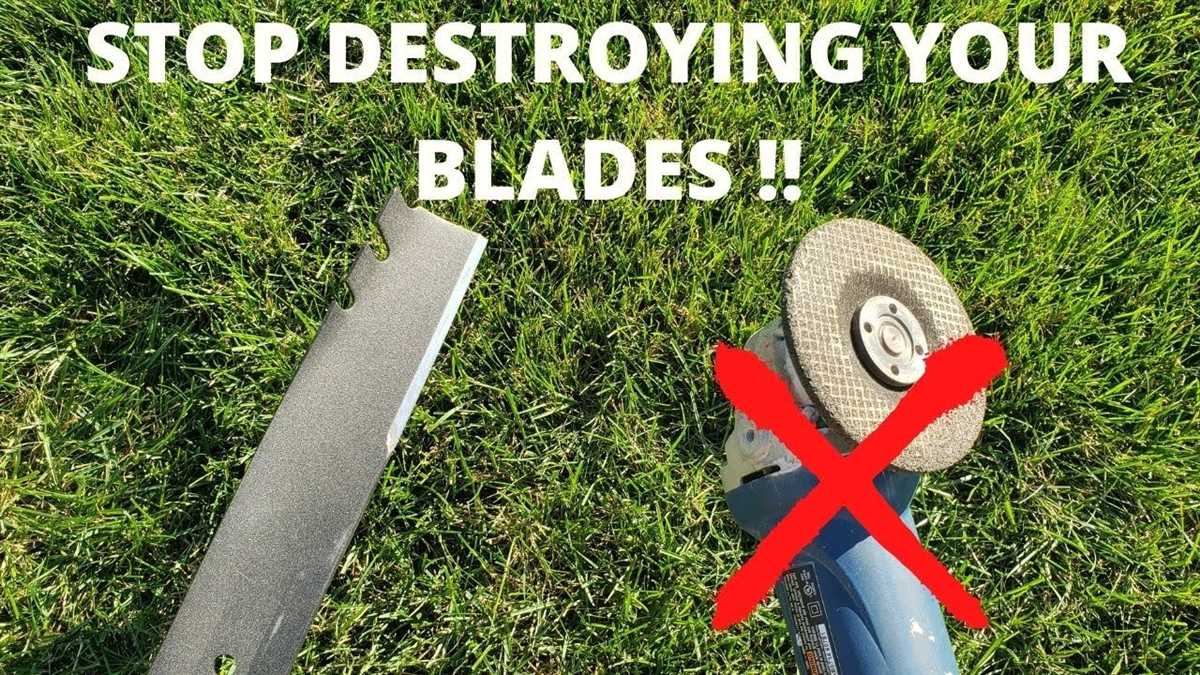
When working with an angle grinder, it is important to have good ventilation to prevent inhalation of dust and fumes. Work in an open area or use a fan to help disperse any airborne particles. Breathing in dust or fumes can be harmful, so taking this precaution is essential for your safety.
By following these safety precautions, you can minimize the risk of accidents and ensure a safe sharpening process for your lawn mower blades. Always prioritize your safety and well-being when working with power tools.
Step 2: Removing the blade
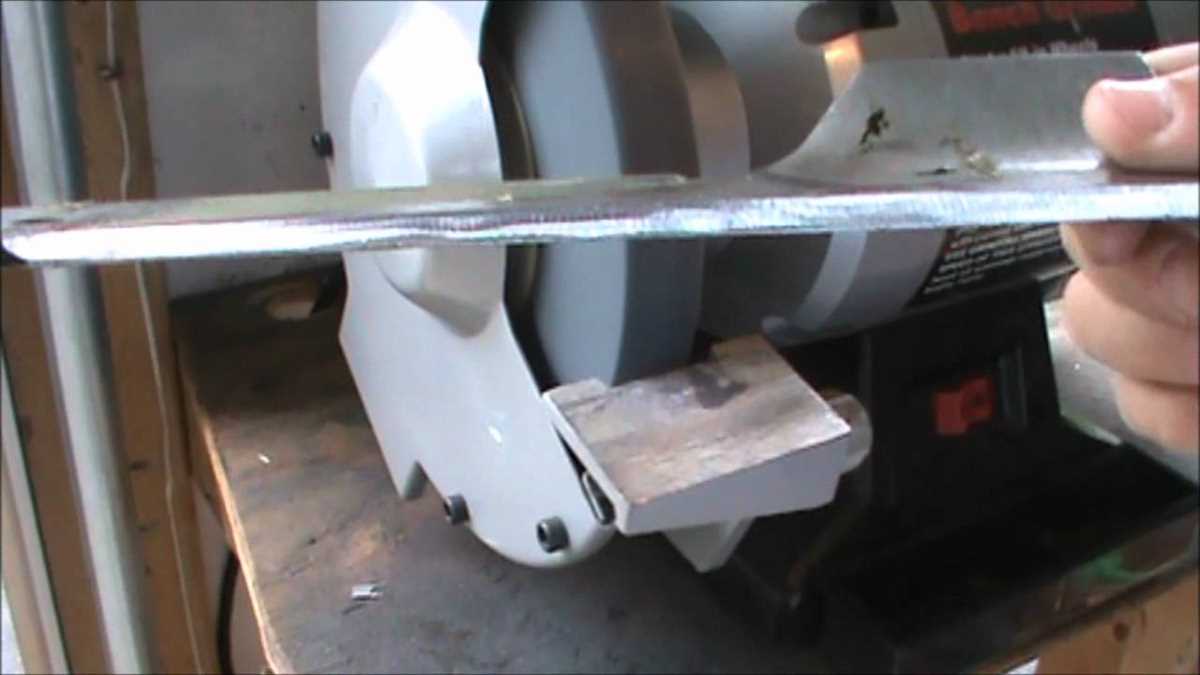
To begin removing the blade for sharpening, first make sure the lawn mower is turned off and the spark plug is disconnected to prevent any accidents. You will need a wrench or socket set that fits the bolts securing the blade to the lawn mower. Refer to the lawn mower’s manual to determine the appropriate size.
Locate the blade and position your wrench or socket set on the bolt. Apply force in a counterclockwise direction to loosen and remove the bolt. If the bolt is tightly secured, you may need to use a breaker bar or extend the length of your wrench for additional leverage.
Once the bolt is removed, carefully slide the blade off the spindle, taking note of its orientation. It may be helpful to place the blade on a clean surface with a marker indicating which side faces down to ensure proper reinstallation later.
Inspect the blade for any signs of damage or excessive wear. If the blade is severely damaged or worn, it may be necessary to replace it rather than sharpen it. However, if the blade is in good condition, proceed to the next step to sharpen it.
Remember to handle the blade with caution, as the edges can be very sharp. Wear protective gloves if necessary to prevent any accidental injuries.
Step 3: Cleaning the blade
Once you have sharpened your lawn mower blade, it is important to clean it thoroughly before reattaching it to the mower. Cleaning the blade will help to remove any debris or buildup that may have accumulated during the sharpening process, ensuring optimal performance and longevity.
To clean the blade, start by using a brush or cloth to remove any loose grass clippings or dirt. Pay special attention to the cutting edges and any hard-to-reach areas. Next, fill a bucket or basin with warm soapy water and submerge the blade. Use a scrub brush or sponge to gently scrub away any remaining dirt or residue.
Note: Be sure to wear gloves to protect your hands during the cleaning process.
After scrubbing, thoroughly rinse the blade with clean water to remove any soap residue. Inspect the blade for any remaining debris or buildup and repeat the cleaning process if necessary. Once the blade is clean, use a dry cloth or towel to remove any excess moisture.
Tip: If you notice any rust spots on your blade, gently scrub them with a steel wool pad to remove the rust and prevent further corrosion.
Once the blade is clean and dry, it is ready to be reattached to the lawn mower. Make sure to follow the manufacturer’s instructions for proper installation.
By taking the time to properly clean your lawn mower blade after sharpening, you can ensure that your mower operates at its best and continues to provide a clean and precise cut for your lawn.
Step 4: Sharpening the blade with an angle grinder
Now that you have secured the blade and put on the necessary safety gear, it’s time to actually sharpen the blade with an angle grinder. The angle grinder is a powerful tool that can quickly and effectively sharpen the blade, but it should be used with caution.
Start by turning on the angle grinder and holding it firmly with both hands. Position the grinder at a 45-degree angle to the blade and slowly run the grinder along the edge of the blade in a controlled motion. Be sure to maintain a consistent angle and pressure to ensure an even sharpening.
As you sharpen the blade, you may notice sparks flying and metal shavings being produced. This is normal, but be careful not to let the sparks come into contact with anything flammable. Additionally, periodically dip the blade into water to prevent it from overheating and damaging the blade’s temper.
Continue sharpening the blade until you have achieved a sharp and clean cutting edge. You can test the sharpness by lightly running your finger along the edge of the blade, taking care not to cut yourself. Once you are satisfied with the sharpness, turn off the angle grinder and carefully remove the blade from the vise.
Before reinstalling the blade on your lawn mower, make sure to clean off any metal shavings or debris that may have accumulated during the sharpening process. This will help to prevent any damage to your mower’s engine or cutting mechanism.
Step 5: Reinstalling the blade
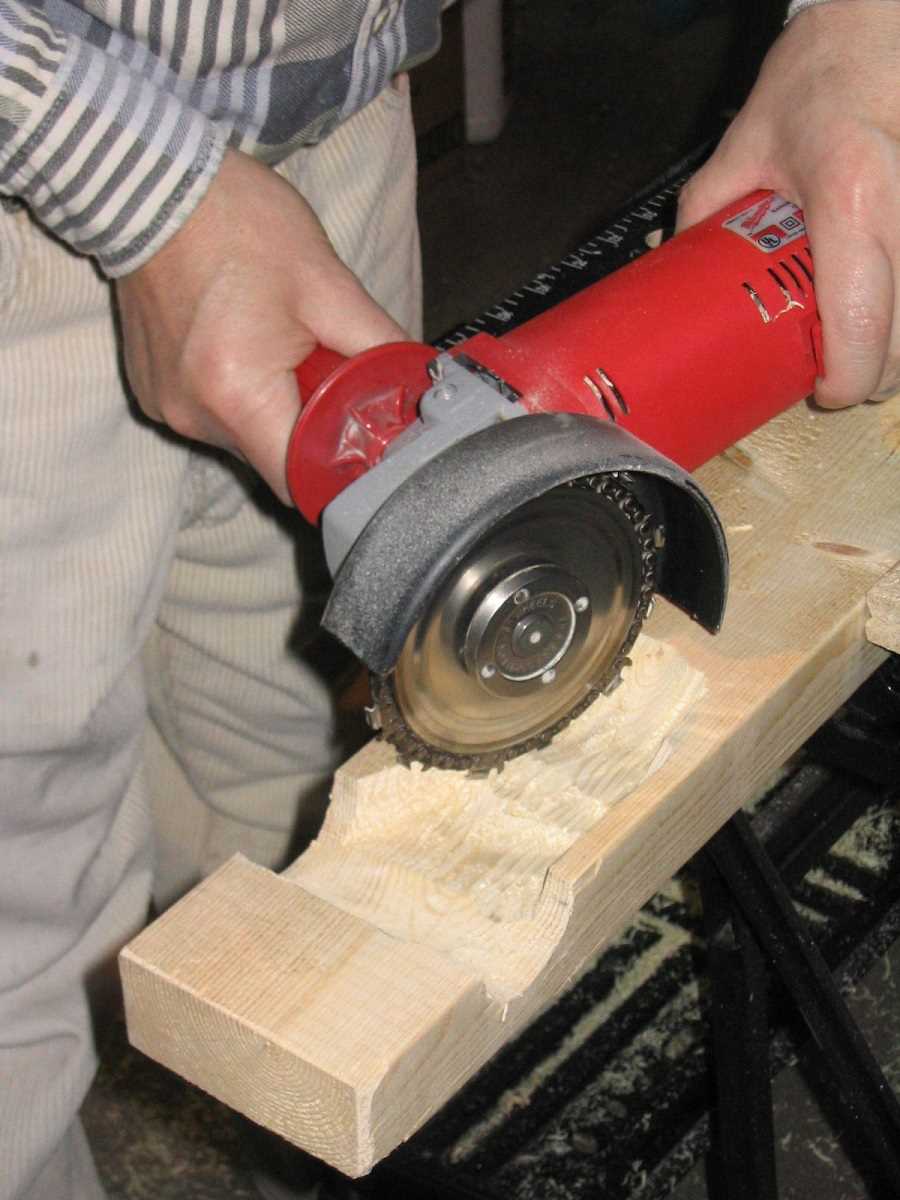
Once you have finished sharpening your lawn mower blade, it’s time to reinstall it back onto the mower. Follow these steps to ensure a proper reinstallation:
- Check the blade for any damage or signs of wear. If the blade is in bad condition, it may be best to replace it rather than reinstalling it.
- Position the blade back onto the spindle, making sure that it sits properly and securely.
- Align the holes in the blade with the mounting bolts on the spindle.
- Insert the bolts through the holes and tighten them securely using a wrench or socket set.
- Make sure the blade is balanced by checking that it hangs level when held by the center hole. If it is not balanced, remove the blade and reposition it until it hangs level.
- Double-check that the blade is securely tightened but avoid over-tightening, as this can lead to damage.
Once the blade is reinstalled, you can test it by starting the lawn mower and observing its performance. If you notice any vibrations or unusual noises, it may indicate a problem with the blade installation, and you should stop the mower and recheck your work. Remember to always prioritize safety when working with lawn mower blades and consult the manufacturer’s instructions if you have any doubts or concerns.
FAQ:
Why do lawn mower blades need to be sharpened?
Lawn mower blades need to be sharpened regularly to ensure a clean cut. Dull blades can tear the grass instead of cutting it, leading to an uneven lawn and increased susceptibility to diseases.
How often should I sharpen my lawn mower blades?
It is recommended to sharpen lawn mower blades at least once a year. However, the frequency may vary depending on the size of your lawn and how often you mow. If you notice a decrease in cutting performance or an uneven lawn, it is a good indication that the blades need sharpening.
Can I sharpen lawn mower blades without an angle grinder?
Yes, you can sharpen lawn mower blades using other tools like a file or a bench grinder. However, an angle grinder is often preferred because it removes material quickly and provides a more precise and even edge.
What angle should I sharpen my lawn mower blades at?
The ideal angle for sharpening lawn mower blades is typically around 30 to 45 degrees. This angle helps to maintain the balance between sharpness and durability. It is important to keep the same angle on both sides of the blade to ensure an even cut.
Can I sharpen my lawn mower blades myself or should I have a professional do it?
You can sharpen your lawn mower blades yourself with the right tools and knowledge. However, if you are not confident in your abilities or do not have the necessary equipment, it is best to have a professional do it to avoid any accidents or damage to the blades.
Video:










